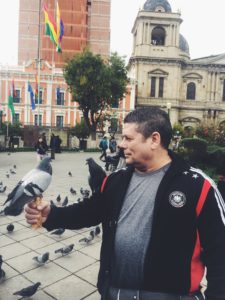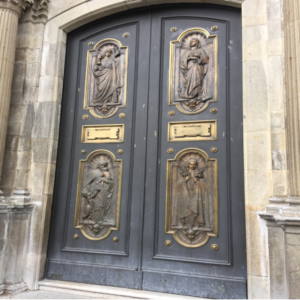Itineraries are set. Forms are filled out. Passports are acquired. Bags are being packed. Snorkels are being fitted. All in preparation for a…field trip?
When the field trip is for a class entitled Bahamian Carbonate Geology, it becomes a bit bigger of a deal than a bus ride to Meramec Springs. It gets its own blog.

The students played Dr. Wronk’s version of Survivor; the class was split into teams and tested on knowledge (and resourcefulness – teammates had to work together for some of those points!). Here, he patiently awaits an answer from sophomore Audrey Thompson during the Survivor focused on corals of The Bahamas.
The students of this semester’s Geology 4841 – Field Studies class, led by Dr. David Wronkiewicz, have – for the last 12 weeks – pored over journal articles, textbook excerpts, field guides, maps, GoogleEarth pics, and research papers.
Boy, have they read some research papers.
They’ve battled it out in quiz bowls over corals, sediments, and the geologically mysterious (yep, mysterious) origins of The Bahamas in general. They’ve asked questions, learned from the charts, photos, drawings, and written words of scientists, researchers, and from their leader Dr. Wronk (a veteran of geology as well as the class/trip).
And in three weeks, suited up in life vests and an armor of knowledge gained from the class, the students – who range from sophomore to graduate levels – will finally get to ditch the papers and books and see San Salvador Island, The Bahamas, with their own eyes. There, they will bunk up in Gerace Research Centre, a former naval base and home to a revolving door of university students, faculty, and researchers journeying in and out throughout the year to take advantage of the opportunities offered by this incredible (and of mysterious origin, don’t forget) geological/biological/cultural/geographical gem.
Stay tuned to the blog as the students prep for the trip, board the planes, and ultimately alight on San Salvador Island. Learn about their interests, their projects, and the research they’ll conduct on their own.
And be entertained as they learn to snorkel 🙂

Discussion during a Survivor competition. Foreground: Senior Tegan Brand looks towards her team for guidance.
Background, left to right: Kasey Buckley, Rose Gartner, Crystal Luttrell, and Emma Huber consult with their own team.

Dr. Wronk and senior Sara Laskowsky exchange a high five after Sara’s sand dune artwork scored her team a point.

Last day of paper discussions; this week’s topic was the origin of paleosols (old soils) in The Bahamas and class was held outside on a gorgeous spring day. For the remaining two class sessions, students will present their ideas for small research projects on Sal Salvador Island.

Freshman Kasey Buckley (left) and sophomore Alisia Hassler are ready to roll! Background: McNutt Hall, the on-campus home base for most students participating in GEOL 4841 Field Studies: Bahamian Carbonate Geology.






